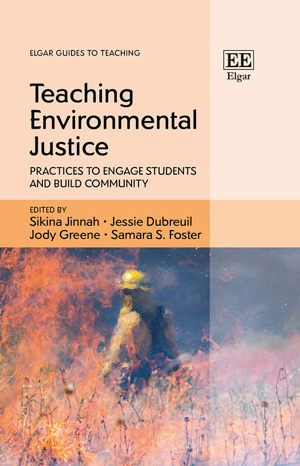Today’s college students face a future marked by an unprecedented global environmental crisis. From climate change to water pollution to deforestation and more, environmental problems are widespread, yet the consequences of these issues are not borne equally. Instead, it is often those in marginalized and under-resourced communities who disproportionately bear the brunt of environmental impacts. Environmental justice offers tools to better navigate these structural inequities and increase the prospects for a healthier planet and a more livable future for all.
But teaching environmental justice principles in the classroom is complex. Instructors need to have a broad, interdisciplinary understanding of the interconnections between social and environmental issues. They also need to know how to respectfully and ethically incorporate knowledge produced by different types of knowledge holders, such as by Indigenous communities and other frontline communities that have deep experience with environmental impacts. And instructors need creative new teaching strategies to connect deeply with students and bolster their resilience and agency in the face of daunting global challenges.
A new book developed by UC Santa Cruz faculty and staff equips educators to more successfully navigate these challenges. Teaching Environmental Justice: Practices to Engage Students and Build Community offers an accessible, flexible, and evidence-based collection of teaching examples, strategies, and classroom tools to help integrate environmental justice into courses in ways that center equity in course design and the student learning experience.
The first section of the book provides instructors with concrete classroom activities for teaching about environmental politics and justice and offers recommendations to help instructors develop appropriate learning outcomes through such projects. The book’s second section then looks beyond the field of environmental politics and justice to reflect on what instructors can learn about teaching this subject from strategies used in other disciplines to center equity and justice in student learning and incorporate other ways of knowing the world.
The book project itself also offers a model for how faculty can advance their teaching practice by learning from one another. It was developed through extensive collaboration among scholar-teachers from 16 institutions across the country who represented a broad range of fields including political science, the arts, economics, astrophysics, history, Native American studies, engineering, online education, ecology, pyrogeography, and many others. The contributors were an exceptionally diverse group that included many BIPOC scholars.
“The learning community that we built in order to produce this book was absolutely crucial,” said UC Santa Cruz Environmental Studies Professor Sikina Jinnah, co-editor for the project. “We helped each other to break out of the norms of our respective disciplines and cross-pollinate our successes in ways that resulted in some really innovative new ideas and recommendations.”
In addition to the book's introductory chapter, Jinnah also contributed a project-based chapter related to her research on climate engineering. The book also has contributions from many other UCSC faculty and staff, including Physical and Biological Sciences Division faculty members Kristy Kroeker, Robin Dunkin, and Enrico Ramirez-Ruiz; Social Sciences Division faculty members Ravi Rajan and Flora Lu; Assistant Vice Provost for Educational Innovation Michael Tassio; and Assistant Director of the Center for Creative Ecologies Chessa Adsit-Morris in the History of Art and Visual Culture Department. Three leaders from UC Santa Cruz’s Teaching and Learning Center (TLC) co-edited the book with Jinnah, including Associate Campus Provost for Student Success and TLC Founding Director Jody Greene, Associate Director for Learning Jessie Dubreiul, and Managing Director Sam Foster.
Representatives from UCSC’s Teaching and Learning Center lent expertise to the project on how to apply the science of learning to support faculty preparation, course and curriculum design, and student success. TLC Founding Director Jody Greene said the center played a supporting role for the collaborative work happening among faculty.
“This book is an outstanding example of what can happen when leading researchers in a shared scholarly field who are dedicated to teaching come together to share and refine their teaching practices,” they said. “The novelty of our approach was to ask these researchers to join in a community of practice and also to work with teaching and learning specialists and educational innovators in other fields as they developed their contributions to the book. We believe instructors both within and beyond the field of environmental justice will find the book very useful, and students will benefit from the approaches it recommends.”
Greene believes the book “beats back the old adage that the best researchers are not the most dedicated educators,” and they hope other groups of scholar-educators may be inspired to try the approach of coming together to share and disseminate innovative teaching practices. The book’s editors and contributors also hope their efforts will inspire more instructors to incorporate teaching environmental justice into their classrooms in a way that offers students hope and equips them with the skills and understanding they need to create positive change.
“Environmental justice is key to addressing the biggest social and environmental challenges our world is facing today,” Jinnah said. “As educators, it’s our responsibility to rise to the challenge in how we prepare the next generation of leaders and equip them with the tools to not replicate the mistakes and injustices of prior generations.”



